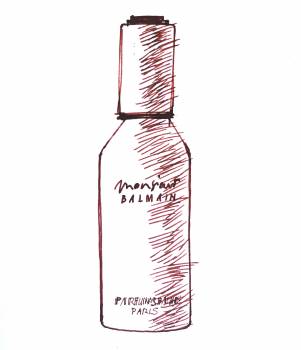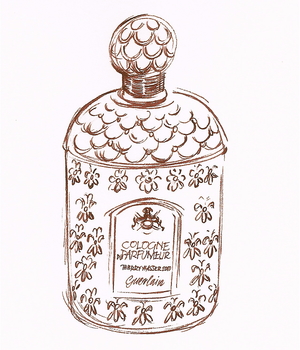Tagged With ‘light’
Balmain
Monsieur Balmain
25 May, 2015
 Lemon verbena is not, it has to be said, the most beautiful shrub in the world, though it’s easy enough to grow in a sunny corner. Its long woody stems give it a rather ungainly appearance, with tufts of spear-shaped leaves at their ends, which appear so late in the season that I’ve often wondered whether the one in my garden was dead.
Lemon verbena is not, it has to be said, the most beautiful shrub in the world, though it’s easy enough to grow in a sunny corner. Its long woody stems give it a rather ungainly appearance, with tufts of spear-shaped leaves at their ends, which appear so late in the season that I’ve often wondered whether the one in my garden was dead.
Aloysia citrodora, to give it its Latin name, grows wild across much of South America, and like so many other garden plants it was brought to Europe by Portuguese and Spanish colonists at some point in the seventeenth century.
Though you wouldn’t grow lemon verbena for its shape, its leaves are a different matter. Long, narrow and folded neatly in half along their length, they are bright green, shiny, and rather rough and sticky to the touch. But what makes them special is the scent they release when crushed, which is so deliriously refreshing that, once I’ve started sniffing them, I find it extremely hard to stop. They make a fine herbal tea (the verveine in which Proust dipped his famous madeleine) and an even finer perfume.
As both its common and Latin names suggest, lemon verbena has a lemony scent – yet that hardly does it justice. Lemons may have a wonderfully fresh, sharp tanginess of their own, but it’s accompanied by the sour, mouth-puckering sharpness of their taste. Lemon verbena has none of that. It has all the freshness of lemon, for sure, but mixed with a gentle sweetness that never becomes cloying, however often you smell it.
This sherbety, sorbet-y scent has all the innocence of childhood: just smelling it can give me the giggles. It might not be the most sophisticated fragrance in the world, but I can think of few better pick-me-ups on a dull dark morning, or for that matter on a sultry summer’s day. And what I love about Monsieur Balmain is that it smells pretty much exactly like lemon verbena, with little else to distract your attention – and why would you want to have your attention distracted from such a delicious scent?
Perfume buffs will already know that Monsieur Balmain was originally created by Germaine Cellier, who was the perfumer behind such justly famous fragrances as Fracas, Bandit, Vent Vert and Jolie Madame. Cellier died in 1976, and Monsieur Balmain was relaunched in 1991 in a new – but apparently faithful – reformulation by Calice Becker, the creator of (among many others) Tommy Girl and Dior’s J’Adore. More recently its bottle has also been redesigned, which means that my illustration is already out of date. For once, though, the new design is classier than the old one, so all respect to Balmain (or rather to Inter Parfums, the company that recently bought Balmain’s perfume licence).
Guerlain
Cologne du Parfumeur
6 August, 2014
 If there’s one scent that appeals to pretty much everyone then surely it’s eau-de-cologne, the zesty, refreshing blend of lemon and herbs whose (probably medicinal) origins are lost in the mists of time. Its oldest surviving surviving incarnation is the German No. 4711 Echt Kölnisch Wasser from – where else – Cologne, which you can buy for not very much from pretty much anywhere, but there are hundreds of other versions, from the cheap and nasty all the way up to Chanel’s divine (and divinely expensive) Eau de Cologne.
If there’s one scent that appeals to pretty much everyone then surely it’s eau-de-cologne, the zesty, refreshing blend of lemon and herbs whose (probably medicinal) origins are lost in the mists of time. Its oldest surviving surviving incarnation is the German No. 4711 Echt Kölnisch Wasser from – where else – Cologne, which you can buy for not very much from pretty much anywhere, but there are hundreds of other versions, from the cheap and nasty all the way up to Chanel’s divine (and divinely expensive) Eau de Cologne.
The basic ingredients of eau-de-cologne are extracts of citrus fruits, which give it its instant freshness, blended with a variety of herbs, usually including lavender and rosemary, which add extra staying-power and warmth. It’s more of a style than a formula, and every different eau-de-cologne has a slightly different combination of ingredients, though they all share a broadly similar character. They all suffer from one drawback, too, which is that they quickly fade away on the skin.
As one of the most historic perfume companies, Guerlain has produced a number of different takes on eau-de-cologne over the years, starting with Eau de Cologne Impériale in 1853, followed by Eau de Cologne du Coq in 1894, the glorious Eau de Fleurs de Cédrat in 1920, and Eau de Guerlain in 1974.
Cologne du Parfumeur was launched in 2010, and is the first not to have been dreamed up by a member of the Guerlain family. Its creator, the Swiss perfumer Thierry Wasser, became the company’s in-house perfumer in 2008, after the retirement of Jean-Paul Guerlain. Wasser’s interpretation of the classic eau-de-cologne retains plenty of citrusy zing, but with more orange than lemon in the mix, which makes it smell slightly sweeter and less astringent than the general run of colognes. The blend of orange used here is particularly ‘green’, which makes a bit more sense if you think of orange flowers surrounded by their glossy dark-green leaves.
Wasser accentuates this ‘greenness’ with tiny amounts of fresh-smelling mint, as well as plenty of lavender and rosemary, those classic eau-de-cologne herbs. I think I also smell a little bit of bracing juniper, which gives Voyage d’Hermès its gin-and-tonic swing. Overall it’s a gentle, appealing scent, and Wasser has given it extra staying-power thanks, it seems, to the inclusion of long-lasting synthetic musks, which add their own soft, slightly sensual touch.
Cologne du Parfumeur comes in Guerlain’s classic ‘bee’ bottle, with fish-scale patterned shoulders, 69 stylised embossed bees on the sides and a rather cheap-feeling plastic top, though customised, hand-gilded versions are available for a suitable fee. What’s most interesting is its label, which includes ‘Thierry Wasser 2010’ – a new departure for Guerlain, and one of the earlier signs that perfumers had started becoming celebrities in their own right.
Boiling perfume
21 August, 2012
You might not think that central-heating boilers would teach you much about perfume, but I’ve just learned a bit more about the subject from mine. My boiler has been playing up again, so Nick, the nice Cypriot heating engineer, came round to fiddle with my thermistors, and while he was here he noticed all the perfume bottles in the room.
It turns out that Nick is into his perfume too, and he asked why I kept all my perfumes in their boxes, which he thought was a bit weird. ‘That’s the first thing I do when I get home,’ he said, ‘unwrap them and throw away all the packaging. I like the designs of the bottles, and you want to look at those not the cardboard boxes, don’t you?’
It’s a good point, and I suspect that most blokes do exactly the same as Nick and keep their perfume bottles on display. Yet your bathroom is a terrible place to keep perfume, especially once it’s been taken out of its packaging. Bathrooms tend to be warm and humid, for starters, and that doesn’t do much for a fragrance’s shelf life.
Worse still is if (unlike mine) they have a window, for nothing makes perfume degrade faster than bright daylight. Direct sunshine is worst of all. Combine that with heat and, within days, your expensive new purchase will start coming apart at the seams. It’s a process you may not – initially at least – be able to smell, but it’s easy enough to see, for as perfume degrades its colour becomes appreciably darker. Soon enough it won’t smell very nice either.
So the moral of the story is – keep your perfume in its packaging. OK, so it’s a shame not to be able to admire a well-designed bottle every day, but it’s the contents you’ve spent all that money on, and surely that’s worth looking after? Oh yes, and even if Nick didn’t know much about perfume preservation, he did a grand job on my boiler.